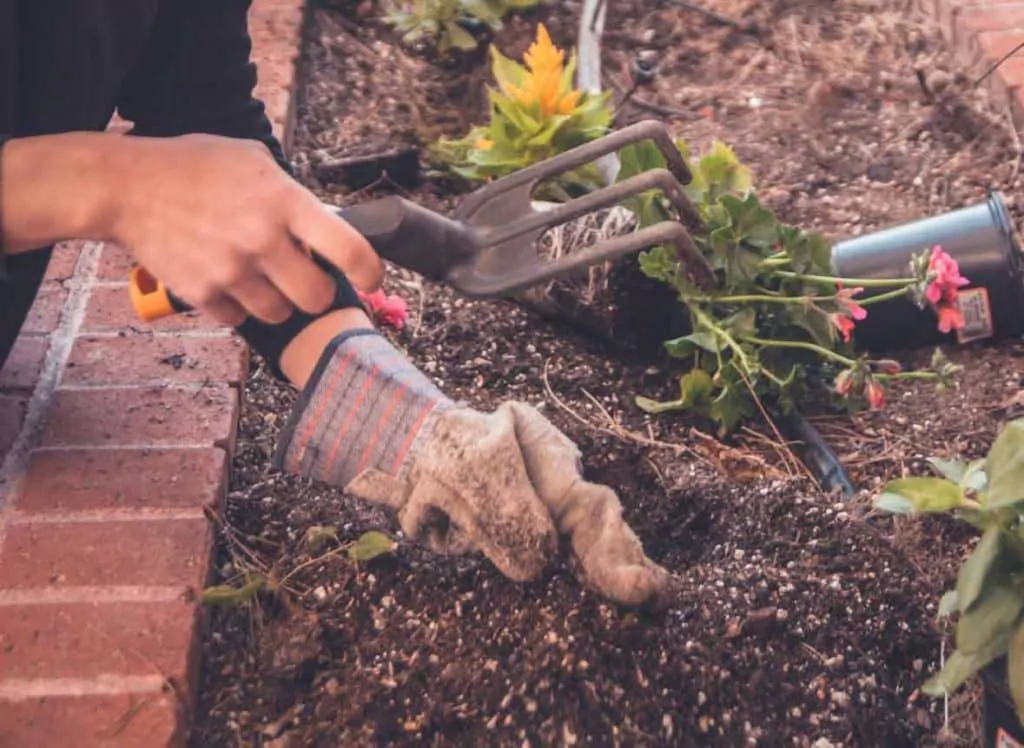
Bermuda grass can invade garden beds quickly and hamper your harvest.
In this guide, you’ll learn how you can get rid of Bermuda grass in flower or veggie garden beds.
Also Read: What Is 30 10 10 Fertilizer Used For?
How to Kill Bermuda Grass in Flower Beds
1. Use Vinegar
Use a 10% vinegar solution as an organic herbicide to kill and remove Bermuda grass in flower beds. Mix a gallon of vinegar, half a cup of salt, and a cup of regular dish soap. Then pour this solution into a sprayer and spray the areas where unwanted Bermuda grass took over.
However, keep in mind that vinegar works like non-selective weed killers. So, always take precautions about the amount of vinegar you use and where you apply it.
2. Use a Non-selective Herbicide
A non-selective herbicide doesn’t care where you apply it; it affects every plant and grass. So, if you choose a non-selective herbicide to fight Bermuda grass, don’t let the herbicide formula touch any plants except the invasive Bermuda grass in the flower bed.
3. Using a Selective Herbicide
A selective herbicide is a great Bermuda grass killer for flower beds. A Selective herbicide will target and eliminate Bermuda grass while not harming other plants.
We recommend Gordon’s Ornamec Grass Herbicide.
follow the instructions provided by the manufacturer while applying the herbicide, so you don’t accidentally damage your plants.
4. Hand Pulling
If you have a small garden, some good old-fashioned hand pulling will remove unwanted grass. Remove all the rhizomes and stolons. Use garden tools if you can’t pull them out easily.
You might notice new grass sprouts after a few days! Then you will need to repeat the process.
5. Solarizing
If you live in an area with plenty of sunlight and heat, you can take advantage of these to eliminate Bermuda grass.
- Mow the grass slightly above the level of the ground. Shortened grass means less strength and growth to deal with.
- Lay a clear plastic sheet to cover the area of Bermuda grass and anchor every few meters with heavy objects like bricks or rocks. This is to make sure strong wind doesn’t uncover the grass.
- Finally, leave it for about 4 to 6 weeks to let the sun and heat do their job.
Applying this technique in a flower bed with existing plants might be difficult. If you already have some plants in the flower bed, don’t forget to temporarily move them to a different bed.
Using Mulch and Cardboard
This method is used to prevent photosynthesis and ultimately kill the grass. For this method, you need some compost, cardboard, mulch, and some sod staples or heavy objects like brick or rock. Now, let’s check out the step-by-step process.
Step 1: Mowing and Raking
First, weed-eat or mow the grass very low, like slightly above the level of the ground. After that, rake up the area properly to remove the stolons and rhizomes.
Step 2: Applying Compost
Apply a layer of compost over the area. The layer should be about half an inch thick.
Step 3: Placing the Cardboard
Now, place cardboard over the composted area. You can recycle some appliance boxes for this. Overlap the edges so that grass doesn’t get an opportunity to grow through any uncovered area.
To make things secure, use sod staples or heavy objects like brick or rock so that no spot gets uncovered at any chance. Lastly, make sure to wet the cardboard thoroughly, don’t skip this.
Step 4: Applying Mulch
It’s time to cover the entire area with a 3-inch layer of mulch.
Step 5: Maintenance
This process is slow but effective. So, before you think of doing anything in the area, you need to wait about 4 to 6 months or sometimes even more. At that time, if you see some seedlings starting to peek, remove them quickly.
If you already have some plants planted in your flower bed, temporarily move them to a different bed. This will make your work easier. It will also reduce the chances of some Bermuda grass getting left at the plant’s base and waiting to take control of your flower bed again!
Get Rid of Grass in Flower Beds without Killing Flowers
You can use a selective herbicide if you want to get rid of grass in your flowerbeds without killing the flowers. Selective herbicide means the herbicide will hurt only Bermuda grass, not most ornamental plants. Be sure to apply the product following the instructions provided by the manufacturer.
Or manually uproot the grass. You can also use the solarization technique or the cardboard and mulch technique to eliminate the grass without harming the flowers.
Frequently Asked Questions
How Do I Permanently Remove Bermuda Grass?
There are multiple ways to eliminate Bermuda grass permanently. Before using any chemical products, you can first try the solarization or cardboard techniques. But if you prefer a faster solution, you can use chemical herbicides instead.
You can always call a lawn care specialist to examine your case if nothing seems to work.
How Do You Keep Bermuda Grass Out of Flower Beds?
You can keep grass out of your flower beds by putting a barrier between the flower bed and your lawn. You can use plastic barriers or landscaping bricks for this. Sink the barrier about 8 cm into the soil so Bermuda grass can’t creep into the flower bed.
Final Thoughts
The ideal place for Bermuda grass should be on your lawn, not in the flower bed. The grass in your flowerbed absorbs vital nutrients and affects your lawn’s curb appeal. If you notice grass invading your flower beds, immediately follow the techniques we have discussed to stop Bermuda grass from spreading in your flower beds.
